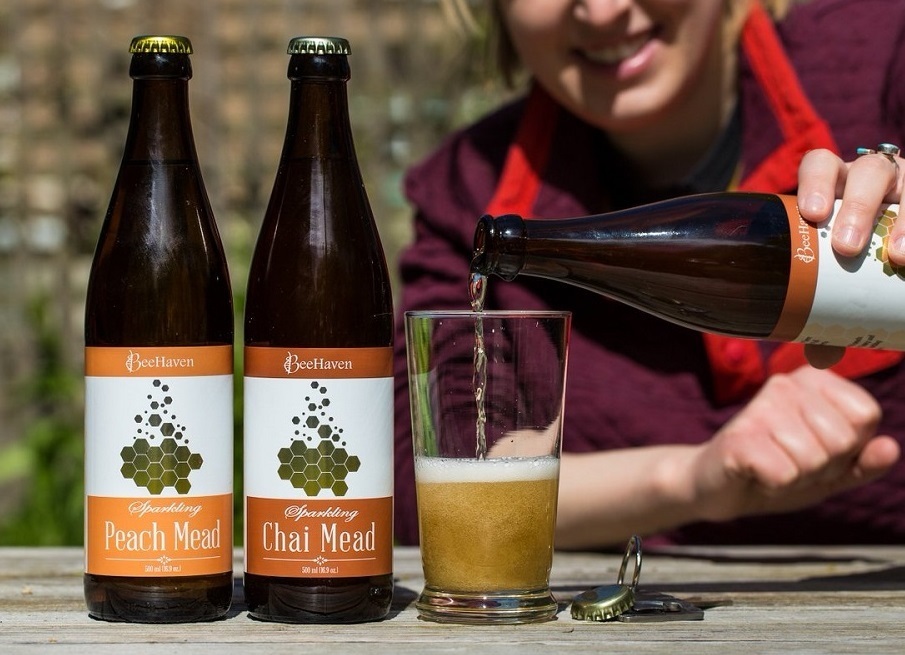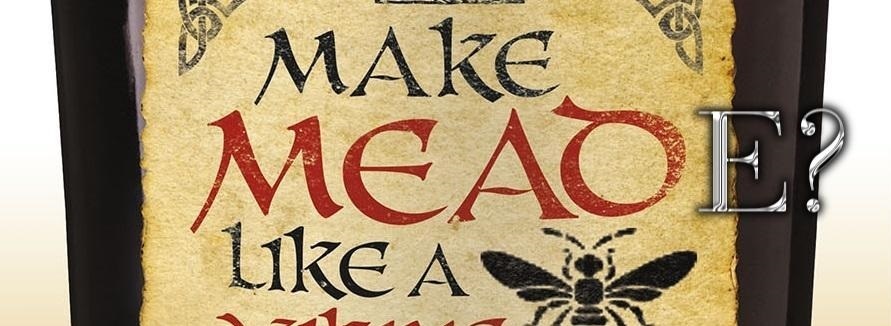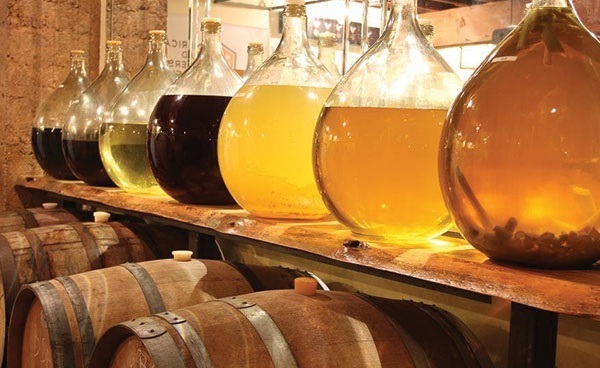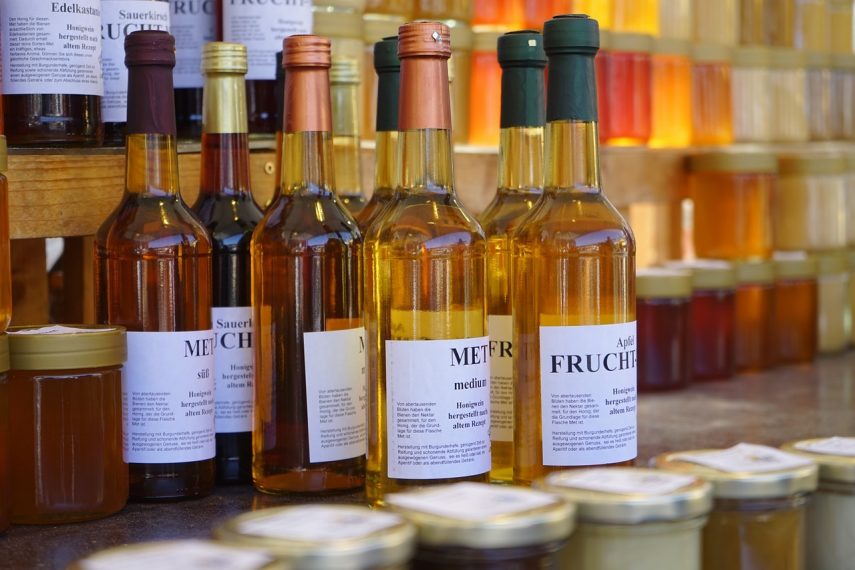Impress your friends – learn some mead basics
Just getting started in mead? You’ve come to the right place … and time. Back in the day, the closest glass of mead could only be had at a renaissance fair or ringside at a Medieval Times Dinner Theater.
Sadly, thus was the state of mead in those dark days.
Nowadays I have a decent chance at finding several varieties of mead at the local wine shop. My, how the times have changed.
So if you’re new to this whole mead scene, head down to wherever your local beer / wine shop is, pick up bottle of melomel (don’t worry we’ll describe what this is later), and get cozy with this week’s article covering the bare minimum of things you need to know about the sweetest of drinks.
What is Mead?
At it’s essence, mead is simply honey, water, and yeast. And just like in beer and wine, the yeast in the honey-water mix serves as an amazing single-celled powerhouse to convert the sugar and nutrients in honey to alcohol and carbon-dioxide (CO2).
However, because the sugar content in honey is higher than that found in beer “wort” or wine “must”, the alcohol content is higher as well, with a typical ABV (alcohol by volume) around the 13% mark. Of course, this figure is a generality, as many home brewers, and meaderies (tinkerers that we are!) have found ways to tone-down the ABV to a platry 3.5%, or even tone-up the ABV to a pants-wetting 23%!
With evidence that mead has been consumed for over 8,000 years, man has had plenty of time to tweak and categorize this drink into a number of distinct varieties. At present there’s over 50+ official types of mead, with more sure to come as it’s popularity starts to pick up.
Here’s a short list of the most popular:
- Braggot: Mead made with malted grain (usually barley)
- Hydromel: Also referred loosely as “Session” mead, this is the term for a weaker mead, usually carbonated abd between 3.5% and 7% ABV.
- Cyser: A mead with apple juice or apple fruit
- Great Mead: This mead is designed to be bottled and aged for several years, sometimes aged in a cask.
- Metheglin: Mead made with spices. Common spices are peppercorns, allspice, cinnamon, nutmeg or cloves
- Melomel: Mead made fruit juice or added fruit chunks
- Mulled Mead: Our go-to Christmas treat, this refers to mead that is heated before drinking. Typically sweeter meads with added spices (Metheglin)
- Sack Mead: With ABVs around between the 14% – 20%+ mark, sack meads are strong. This is Ulf’s favorite (our in-house viking).
- Show Mead: Mead made of straight-up honey, water and yeast. No juices, spice or additives.
- Sparkling Mead: A carbonated mead, similar to champagne.
How to Serve Mead

Pouring Mead
Whether to serve it chilled or at room temperature depends on you own preference and palette, however we recommend that dry, lighter mead be served chilled to obtain the best flavor, while those meads that are stronger in flavor (such as those made from higher concentrations of honey, or from darker honey) be served at room temperature, like a wine-port or apéritif.
Additionally, just like any other drink out there, mead can also be mixed with different flavors if you want to tweak or further enhance the original taste. Some folks add fruit or juices — similar to a sangria — or bitters to compliment the naturally sweet taste of mead.
Mead or Meade?

Mead . . .or Meade?
It’s safe to say that mead is not well understood by the wider drinking public and is often associated almost exclusively to the fierce Norseman, Vikings, or medieval Knights in the middle-ages. Certainly mead is not as viable an option behind the bar at your local pub.
Worse yet, some people still confuse mead as a sub-category of wine or beer, despite the fact that mead is in a class all its own, and with its own unique taste.
Adding to the confusion is the number of different names or spelling in which mead is referred to including “honey-wine,” the olde-English spelling of “meade,” or the numerous sub-categories of mead available.
Despite lacking the marketing chops of beer and wine, mead is quietly making its way back from the dark ages. According to recent research, meaderies in the U.S. alone have doubled during the last three years, with interest only continuing to grow — so do your part and consume more of it!
Seriously, Did Vikings Drink Mead?
The Norsemen and Norse-women of old most certainly drank their fair share of mead, with written evidence in such epic poem like Beowulf (1000A.D.), describing a culture where centralized “Mead” Halls, (aka Longhouses or Great Halls) served as a common area where the nobles and common people of the tribe would assembly to feast, commiserate, and well…drink a lot of alcohol.
Although mead was the drink of choice in the early middle ages, it’s dominance was slowly replaced by beer as agriculture took off in these northern lands, making abundant the grains necessary to make beer production.
Additionally the Trappist Monks in the Netherlands took a serious liking to beer, meticulously developing stable processes which produced consistently delicious beers, thereby molding the tastes of the time to their wonderfully tasty brews.
http://ithinkaboutbeer.com/2013/05/09/the-brewing-monks-a-brief-history-of-the-trappist-order-and-monastic-brewing/
Mead Home Brewing FAQs

Mead Tasting Room
Brewing mead is not for the faint of heart. It takes nerves of steel. It takes patience the of a monk. It takes a sense of adventure. But most of all it takes honey, water and yeast, and just enough basic knowledge to avoid producing a liquid that unavoidably looks like pee, but tastes like it as well.
So to start you off on the right foot, and to avoid making sweet piss-water, we’ve put together answers for FAQs we often get from aspiring mead brewers out there.
Q: Is Mead Expensive to Make? On average a 750 ml bottle of mead takes about $4-7 of investment to produce. This represent the costs of the bottles, corks, an allowance for the equipment, and the ingredients, namely; honey, nutrients, and yeast. Honey will be the most expensive part of the equation, and thus the primary reason for the range in cost.
On the upside, a decent still mead can cost you around $15 – 20 at the store.
Do the math; you are totally ahead in the equation, that is, if you plan on selling your mead rather than consuming it all like a drunken viking.
Q: What Equipment Do I Need To Make Mead? Strictly speaking all you need to make mead a receptacle to keep your honey-water mix. But you’re not a savage are you!? You want to produce the finest mead you can afford, right?
If you’re serious about making good, drinkable mead, you’ll need some basic equipment to get started. Here’s what we would recommend to a new mead brewer:
- Mixing bucket and lid. Used as a “primary fermentation vessel”
- Glass carboy. Used as your Secondary fermentation vessel, and to help avoid introducing oxygen into the must at later stages.
- Carboy handle. This handy little device connects around the top of your glass carboy and gives you a way to get a firm grip on your carboy so you can move it. It’s a big help when dealing with a full carboy, which can weigh upwards of 50 to 55 pounds.
- Fermentation lock / air lock. You can find these at your local home brew store. They fit in the top of your glass carboy and allow carbon dioxide to escape from your carboy while preventing bacteria from coming in.
- Rubber Stoppers. These fit into the tops of your carboy and bucket to fit your air lock, helping to get the seal airtight.
- Mixing spoon / paddle. Used to oxygenate your honey-water “must” during primary fermentation.
- Funnel. The funnel will be used to transfer liquids between the mixing bucket and the glass carboy.
- Hydrometer. This handy gadget looks like a floating thermometer, and is used to derive the abv in your mead
- Thermometer. Any liquid-compatible thermometer will do here. You will be taking the temperature of the must to calibrate your specific gravity readings, and to make sure the must is within the temperature range that your yeast can handle before you pitch it.
- Racking cane and plastic tubing. A racking cane is simply a cane-shaped hard plastic tube that is adapted to connect to plastic tubing. You will be using this combo to transfer your must from carboy to carboy.
- Wine bottles. These are easy to come by. We like to use clear bottles, since they tend to show off the color the mead. You’ll need 5 for every gallon of mead produced.
- Corks. This is no screw-cap drink. Get some good corks. As a rule of thumb, the thicker and longer the cork, the longer your mead will last.
- Corker. These come in hand-held, table-top, and floor-mounted versions (in increasing order of expense). If you’re doing it regularly, get a solid floor-mounted corker
- Pen and notebook. You will definitely want to keep a log for your mead so that you can help your future self on your next batch of mead.
For more information on the equipment needed, visit our Guide To Making Mead At Home.
Q: How Long Do I Wait Before Tasting? You can taste the homemade mead as soon as the fermentation bubbles disappear. This usually occurs after the three months mark.
Q: How do I stop the fermentation process? While we prefer our yeasts to peter out naturally, there a couple of reasons why brewer might want to end the fermentation process quickly. Perhaps you need fermentation to match a specific gravity, or you’d like to keep your mead consistent from batch to batch. Some brewer halt the process to reach a certain sweetness.
So how to you do it?
If you’re okay with adding some “chemicals” to your mead, you simply need to add Campden pills to your must. Also known as potassium or sodium metabisulfite, many mead and wine makers will use this to kill the yeast, thereby stopping fermentation altogether. It also helps prevent bacteria from spoiling your mead after it’s been bottled.
If you don’t like the idea of using chemicals, you can either cool (“cold shock”) or heat (pasteurize) your mead to stop fermentation. Cooling your mead forces the yeast into a dormant state, while pasteurization will kill the yeast.
Q: How Can I Make Sparkling Mead? In order to make your mead sparkle, you just have to add some sugar after the initial fermentation. For more on how to do that, click here!
Q: Who invented mead? Honey and Water fermentation is a natural process, but there is evidence that purposely made / drinkable mead was being produced between 7,000 – 8,000 B.C in China.
Q: Can I easily start a meadery? No.
Q: How important is sanitation? Truth-be-told, the healthy yeast in mead do a pretty good job of keeping out unwelcome bacteria, but in the world of brewing, consistency is key. You may actually make descent mead with little-to-no sanitation protocol, but trust us, if you’re cleanliness is lax, the taste of your mead will vary from batch to batch.
Sometimes widely.
Make consistently good mead by thoroughly sanitizing anything that touches your mead. We recommend Star San: a strong, biodegradable sanitizing concentrate, and the home-brewing industry standard.
Q: What is a hydrometer? A hydrometer is not a tool that measures the flow of water, it’s also not a mystical beast with nine heads from Greek mythology (See Hydra). Despite the confusing name, a hydrometer is a handy tool that measure the specific gravity of a solution compared to water. The specific gravity can be used to determine the alcohol level in your mead.
Some Mead Factoids
- Honey wine is likely the oldest alcohol on earth. Just how old exactly? Cave painting in Spain dated to 8000 B.C., reveal ancient man collecting honey in satchels, while Chinese vessels from 7000 – 8000 B.C showed the chemical footprints of mead fermentation.
- Ancient Greeks believed that mead was sent from heaven and collected by bees and hence it is also known as the “drink of gods” and “nectar of gods”
- Mead mixed with certain spices and herbs was even used as a medicine in England. Now known as “Metheglin”, this word is a precursor to the modern English word “medicine”
- The taste of mead varies with the type of pollen and nectar used to make the honey.
- There are more than 50 types of mead and each differs in taste and looks.
- Honey wine is a royal drink. Queen Elizabeth is huge fan of it and even maintains her own secret recipe, which is a mixture of bay leaves, thyme, sweet briar and rosemary. We asked her to send us some so we can taste it, and we’ll report back to you when we get it.
- The word “honeymoon” is actually been derived from mead. In medieval tradition, newlyweds used to drink mead for a full moon cycle. According to their beliefs, this would result in a fruitful reunion. This belief was taken so seriously that a full month’s supply of mead was included in dowry.
Well there you go, you’ve got enough to sound knowledgeable at a cocktail party (and hopefully one with mead).
Now go forth and profess the good news, my young apprentice!


